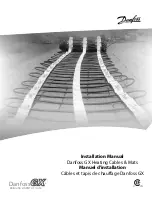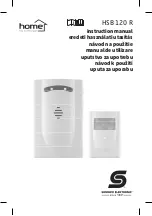
1
Concord
Getting to Know Your
Security System
This security system is designed to protect your family and
property, whether you are on the premises or away.
This manual describes how to operate your system. It
describes basic arming and disarming commands as well
programming instructions for system features.
The dealer or installer may have already discussed with
you many details concerning your system. Specific setup
information is included in the “Appendix A: User Sheets”
on page 29.
Overview
Your security system is comprised of different compo-
nents. Each component plays a special role in system oper-
ation:
The panel is at the heart of your system.
It stores the intelligence to monitor all the
sensors and devices in the system. The
panel is the piece of equipment that ini-
tiates a call to the central station in an
alarm situation. The panel circuitry is
enclosed in a steel cabinet and is installed
out of the way of household or workplace
traffic.
Touchpads allow you to
communicate with your
panel. You’ll use a touchpad
to arm, disarm, and program
your system.
Door and window sensors
protect the perimeter of your home
by alerting the panel when a door or
window is opened.
Motion detectors in hallways or
individual rooms detect a person
moving across the field of detection.
Environmental sensors such as
smoke and heat detectors remain
alert for the presence of fire or car-
bon monoxide 24 hours a day.
Your system may contain a Phone
Interface and Voice Module that
allows you to use a Touchtone phone
located on- or off-site as a touchpad.
The module also makes it possible to
get voice feedback from speakers,
guiding and informing with spoken
prompts and system status reports.
Your system may contain an optional Energy
Saving Module which helps you save money
by allowing your system to monitor and con-
trol the temperature of your home or business.
The module can also be programmed to alert
the central station in the event of furnace or
AC failure.
Your system may contain an optional
SuperBus® 2000 Cellular Backup
Module which expands your systems
reporting means with cellular telephone
reporting. The module can automati-
cally report alarms with a cellular tele-
phone in case of inoperative landline telephone
communications.
Communicating with the Panel
Touchpads allow you to communicate with the panel. In
turn, the system can be set up to communicate with you
through:
❑
status beeps from touchpads and speakers,
❑
alarm sirens,
❑
scrolling text on touchpads,
❑
display text on fixed display touchpads,
❑
voice feedback over Touchtone phones or interior
speakers, and
❑
system information over pagers.
Instructing the Panel
Most of your instructions to the panel consist of this basic
pattern:
Not just anyone can walk up to a touchpad and operate
your security system. Before the system will process most
commands, users are required to enter a pre-programmed
4-digit access code.
Keychain touchpads that are enrolled as part of the system
do not require an access code, but are usually kept in an
individual’s pocket or purse.
If you would rather use an actual
key to arm and disarm the system,
your security dealer can install a
special key and keyswitch in your
home.
Touchpads—Your System Interface
There is a broad range of touchpads that can be used with
your panel—from a single-button panic sensor which
sends only panic alarms, to an alphanumeric touchpad that
displays text and allows extensive user programming.
S t a t u s
F e a t u r e s
p r e s s b o t h
L i g h t s
S y s t e m
A w a y
P a g e r
O f f
N o D e l a y
p r e s s b o t h
p r e s s b o t h
T e s t S y s t e m W e e k l y
S i l e n t
S t a y
D
*
7
0
#
8
B
A
4
1
5
6
2
3
B y p a s s
M e n u
C
9
P r o g r a m U s e r S e t t i n g s
p r e s s 0 - 9 f o r o t h e r e n t r i e s .
P r e s s 1 f o r O F F ; p r e s s 2 f o r O N ;
P r e s s # t o s e l e c t o p t i o n o r a c c e p t e n t r y .
0 6
0 7
0 5
0 4
1 3
1 4
1 2
1 1
A r m t o S T A Y
Q u i c k G u i d e
D i s a r m S y s t e m / C a n c e l A l a r m
i f d e s i r e d .
2
0 1
0 2
0 3
3
1
0 8
0 9
1 0
P r e s s
t o d e s e l e c t o p t i o n o r c a n c e l e n t r y .
C l o s e a l l p r o t e c t e d d o o r s a n d w i n d o w s .
P r e s s 3 + C O D E .
E x i t p r e m i s e s t h r o u g h d e l a y d o o r .
2
3
1
P r e s s 2 + C O D E .
C l o s e a l l p r o t e c t e d d o o r s a n d w i n d o w s .
P r e s s 4 t o a r m d e l a y d o o r s i n s t a n t l y ,
A r m t o A W A Y
Z o n e / S e n s o r N u m b e r
P r e s s 1 + C O D E .
2
1
P r e s s A o r B t o s c r o l l t h r o u g h m e n u s .
M a k e s u r e s y s t e m i s d i s a r m e d .
2
1
P r e s s 7 + 1 t o t u r n C H I M E o n o r o f f .
M a k e s u r e s y s t e m i s d i s a r m e d .
2
1
T u r n C H I M E O n / O f f
P r e s s B Y P A S S + C O D E + S e n s o r N o .
A r m s y s t e m t o d e s i r e d l e v e l .
B y p a s s S e n s o r s
S y s t e m i s O K
S t a t u s
F e a t u r e s
p r e s s b o t h
L i g h t s
S y s t e m
A w a y
P a g e r
O f f
N o D e l a y
p r e s s b o t h
p r e s s b o t h
T e s t S y s t e m W e e k l y
S i l e n t
S t a y
D
*
7
0
#
8
B
A
4
1
5
6
2
3
B y p a s s
M e n u
C
9
A r m e d
R e a d y
8845G02A.DSF
C o m m a n d
A c c e s s C o d e






































